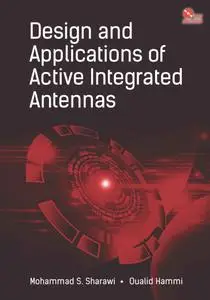Design and Applications of Active Integrated Antennas
Artech House | English | 2018 | ISBN-10: 1630813583 | 276 pages | PDF | 21.88 MB
Artech House | English | 2018 | ISBN-10: 1630813583 | 276 pages | PDF | 21.88 MB
by Mohammad S. Sharawi (Author), Oualid Hammi (Author)
This comprehensive new resource guides professionals in the latest methods used when designing active integrated antennas (AIA) for wireless communication devices for various standards. This book provides complete design procedures for the various elements of such active integrated antennas such as the matching network, the amplifier/active element as well as the antenna. This book offers insight into how active integration and co-design between the active components (amplifier, oscillator, mixer, diodes) and the antenna can provide better power transfer, higher gains, increased efficiencies, switched beam patterns and smaller design footprints. It introduces the co-design approach of active integrated antennas and its superior performance over conventional methods.
Complete design examples are given of active integrated antenna systems for narrow and wideband applications as well as for multiple-input-multiple-output (MIMO) systems. Readers find the latest design methods for narrow and broadband RF matching networks. This book provides a complete listing of performance metrics for active integrated antennas. The book serves as a complete reference and design guide in the area of AIA
Review
Nonfiction, Best of the Bunch: This new resource guides professionals in the latest methods used when designing active integrated antennas (AIA) for wireless communication devices for various standards. This book provides complete design procedures for the various elements of such active integrated antennas such as the matching network, the amplifier/active element as well as the antenna. This book offers insight into how active integration and co-design between the active components (amplifier, oscillator, mixer, diodes) and the antenna can provide better power transfer, higher gains, increased efficiencies, switched beam patterns and smaller design footprints. It introduces the co-design approach of active integrated antennas and its superior performance over conventional methods. Complete design examples are given of active integrated antenna systems for narrow and wideband applications as well as for multiple-input-multiple-output (MIMO) systems. Readers find the latest design methods for narrow and broadband RF matching networks. This book provides a complete listing of performance metrics for active integrated antennas. The book serves as a complete reference and design guide in the area of AIA. –Stevo's Book Reviews on the Internet
Sharawi and Hammi describe the design and application of active integrated antennas, predicting that they will be used in future wireless terminals to provide higher gain values, reconfigurable frequency, and pattern capabilities that can select the best available spectrum for use or tilt their beam for better reception. On-chip antenna arrays at millimeter-waves will need active integrated antennas to compensate for the path losses at such high frequencies, they say, They cover impedance matching methods, amplifier design, antenna fundamentals, active integrated antennas, and a co-design approach. –Protoview
With the publication of Design and Applications of Active Integrated Antennas, Mohammad S. Sharawi (Professor of Electrical Engineering at King Fahd University of Petroleum and Minerals, Dhahran, Saudi Arabia) and Oualid Hammi (Associate Professor in the Electrical Engineering Department at the American University of Sharjah, Sharjah, United Arab Emirates, and an Adjunct Associate Professor of Electrical and Computer Engineering at the University of Calgary, AB, Canada) have created a comprehensive resource guide for professionals with respect to the latest methods used when designing active integrated antennas (AIA) for wireless communication devices for various standards. This textbook formatted resource provides complete design procedures for the various elements of such active integrated antennas such as the matching network, the amplifier/active element as well as the antenna; offers insight into how active integration and co-design between the active components (amplifier, oscillator, mixer, diodes) and the antenna can provide better power transfer, higher gains, increased efficiencies, switched beam patterns and smaller design footprints; introduces the co-design approach of active integrated antennas and its superior performance over conventional methods; and provides complete design examples are given of active integrated antenna systems for narrow and wideband applications as well as for multiple-input-multiple-output (MIMO) systems. AIA students will find the latest design methods for narrow and broadband RF matching networks. Unreservedly recommended for college and university library Technology instructional reference collections, Design and Applications of Active Integrated Antennas provides a complete listing of performance metrics for active integrated antennas and serves as a complete reference and design guide in the area of AIA. It should be noted that Design and Applications of Active Integrated Antennas also includes an instructional DVD. –Midwest Book Review –This text refers to an out of print or unavailable edition of this title.
About the Author
Mohammad S. Sharawi is currently a Professor of Electrical Engineering at King Fahd University of Petroleum and Minerals (KFUPM), Dhahran, Saudi Arabia. He is the founder and director of the Antennas and Microwave Structure Design Laboratory (AMSDL). Prof. Sharawi is a Senior Member IEEE and Fellow IET. Oualid Hammi is an associate professor in the Electrical Engineering Department at the American University of Sharjah, Sharjah, United Arab Emirates. He is also an adjunct associate professor of electrical and computer engineering at the University of Calgary, AB, Canada. He received his M.Sc. in electrical engineering from the Ecole Polytechnique de Montreal, Universite de Montreal, Montreal, QC, Canada and his Ph.D. in electrical engineering from the University of Calgary, AB, Canada. –This text refers to an out of print or unavailable edition of this title.



